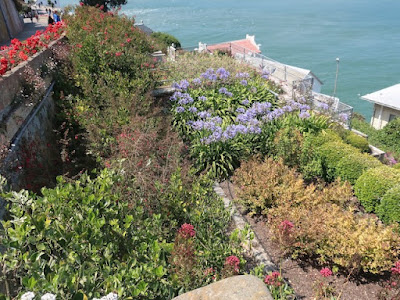While in the San Francisco area, we visited Alcatraz, the most famous jail in the world. It's now owned by the
National Parks Service, though they don't run the ferries out to the island. We used
City Experiences to get there. On Pier 33, the launch point, they have a large model of the island we were about to visit.
From 1850 to 1933, the island was occupied by the United States military and used as a fort to protect San Francisco. The entrance was heavily guarded, though the watch tower is from the prison era (1933 to 1963).
 |
| Watch Tower |
 |
| The main way in from the dock |
 |
| A canon aimed to repel invaders |
 |
| Fresh water tower |
One of the buildings was turned into a mortuary for the prison, though very few prisoners died while incarcerated, even though a lot of them were "lifers."
 |
| Mortuary |
The prison tour features an audio guide (in multiple languages). My brother-in-law worked for the audio guide company back in the day and stayed on the island, providing background noise like prisoners shouting and stuff.
 |
| Prison entrance |
The audio guide walks visitors through the incarceration experience. The first room is the shower room, where prisoners got their prison clothes and had to shower in front of everyone to make sure they weren't smuggling anything in.
 |
Shower room
|
The prison had four cell blocks, A through D.
 |
| Hallway between blocks B and C |
All the prisoners had individual cells, ten feet deep and four and a half wide. They don't provide much space considering the bunk, toilet, and sink using up a lot of room. Of course, the inmates had minimal possessions, so they didn't need a lot of space.
 |
| A typical new cell (toilet missing!) |
The end of the blocks by the entrance to the cafeteria was called Times Square.
 |
| Times Square |
Another famous spot (that we were not able to visit) is the recreation yard. Prisoners would spend a few hours outside. They would play sports or games or just hang out in the sunshine (if there was any).
 |
| Picture of the yard |
D Block was the solitary confinement area of the prison. Any misbehaving prisoners were moved here. Some of the cells were completely sealed off from daylight, making time served there very difficult.
 |
| Door to D Block |
 |
| Regular cells on D Block |
 |
| A typical cell |
 |
| Famous inmates (Al Capone on the far left!) |
 |
| The "no light" cell |
The prison had a library. Convicts could read magazines or books, sometimes getting a better education than they received on the outside.
 |
| No more books in the library |
Inmates worked at menial jobs at the prison and made menial salaries. They could spend the money on cigarettes (though they received a couple of packs each week regardless of whether they smoked or not) though many inmates took up hobbies like painting or playing musical instruments.
 |
| A cell for a painter |
The prison did have an area for visitors to see prisoners. The windows are very small and allowed no physical contact.
 |
| Visiting area |
 |
| Only four bays for visitation |
Some of the cells are more decorated with what was typical back in the prison years. A cell is made up like Frank Morris's. He's the guy who lead two other prisoners in an escape in 1962; they were never found. The cell shows the hole in the vent and a fake head used to fool guards into thinking he was still in his cell.
 |
| An escapee's home |
The final stop on our inside tour was the cafeteria. This room was one of the most dangerous in the prison. The inmates had utensils and they were all together in a close space. A handful of guards would be in the room. The walls had tear gas canisters attached in case a riot broke out (though the handful of guards would be out of luck!). The cooking area is behind bars and the set of larger knives was hung with silhouettes behind them so the cooks could know if any potential weapons were missing.
 |
| In the cafeteria |
 |
| Knife rack |
As I mentioned earlier, Frank Morris and two other inmates "disappeared" from the prison in 1962. The next year the prison was closed without much fanfare.
 |
| Photo of the last day |
The exhibit just before the gift shop provides information about prisons and prison populations in the United States and abroad. They also discuss various laws and show some "tools of the trade."
 |
| Handcuff technology through the ages |
 |
| Wants his sister to stay |
Outside, the landscape has pockets of flowers and vegetation, brightening up an otherwise dreary island.
 |
| Roses of Alcatraz |
 |
| More flowers |
The administration building has some exhibits on the guards and other workers on the island.
 |
Entrance to the Admin building
|
 |
| Guard's uniform |
A Thompson sub-machine gun (popularly known as a "Tommy gun") is on display with an ad that claims "It's the safest gun to shoot in city streets!".


















































No comments:
Post a Comment